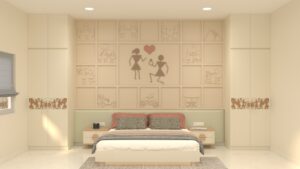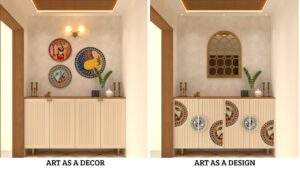In a world chasing Pinterest-perfect homes, I find magic in the raw, soulful beauty of Indian folk art — where every line holds history and every color whispers a memory. It’s not just something to frame or hang. It’s filled with stories, culture, and emotion. In its asymmetry, hand-drawn lines, and earthy tones lies an authenticity that modern or global design often misses out.
Yes, we see it often—Warli on wall hangings, Kalamkari on cushions, Madhubani above consoles. But too often, these are just visual add-ons. Beautiful, yet disconnected. What’s missing is intention. We rarely ask: Why this art? What is it saying? Does it fit the energy, the materials, or the mood of the space?
Folk art speaks many languages—Warli, Madhubani, Kalamkari, Kerala Mural, Gond, Pichwai—each with its own rhythm, palette, and voice. Treating them as one-size-fits-all décor flattens their richness.
Folk art is more than decoration—it’s rhythm, story, and soul. The dotted patterns of Gond, the flowing lines of Kerala murals, the sacred symbols of Pichwai—each brings its own energy. When placed with care—Warli on wood, Madhubani on linen, a mural on lime-washed walls—they don’t just match the space, but they belong there.
With the right intent, folk art doesn’t just fill a wall—it becomes part of the home’s heart.
At Akarsh Designs, we craft homes around themes—Modern Boho, Japandi, Rustic, Indian Transitional, and more. Each space tells a story, and now, we want Indian folk art to become part of the narrative—Not only the decorative add ons but a core design layer—woven into the soul of the space.
At Akarsh Designs, we’re not just using folk art for its aesthetic—we’re exploring how it can become personal.
Take for instance this Warli render below—etched as a wooden panel in a master bedroom. It doesn’t just depict tribal life; it tells the story of the couple who lives there. How they met, how he proposed, the milestones they’ve shared. It’s a timeline told in folk art—intimate, rooted, and emotionally rich.
Old folk traditions like Warli and Madhubani can be customized this way—telling personal stories through visual language. They become emotional anchors in the home, not just surface decor.
In theme-based interiors, Indian folk art can be more than a decorative touch—it can deepen the story. In a Japandi or modern minimalistic home, a hand-drawn Warli panel etched on wood, blends effortlessly with clean lines and calm tones. For Modern Rustic , Kalamkari florals painted on shutters or headboards bring softness and tradition. In an Indian transitional space, a Pichwai panel becomes a focal point, adding spiritual depth to modern elegance. And in Eclectic Boho, Gond art with its playful, nature-inspired forms energizes walls or furniture. When chosen thoughtfully, folk art becomes part of the theme.
This is not just an aesthetic pursuit, but it’s a design philosophy. We are developing theme-based folk art integrations across interior styles like Japandi, Rustic Boho, and Minimal Indian, where every art form is thoughtfully woven into the story of the home.
Our journey includes collaborating with artists, CNC studios, and digital print labs to create bespoke applications that are both rooted and relevant.
We are working on building a library of mockups and inspirations—showing how folk art can shape not just walls, but furniture, flooring and ceilings. Above all, I hope to partner with clients who seek more than trending Pinterest fashions—who want homes with soul, story, and intention.
We’ve welcomed Scandinavian simplicity and Japanese calm into our homes—so why not invite our own traditions too? Let Madhubani, Warli, and Pichwai be more than art—let them be personalised storytellers in our spaces.

